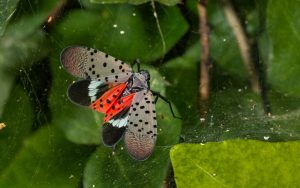Iowans are warned to be on guard for harmful, hungry insect
July 29th, 2025 by Ric Hanson
(Radio Iowa) – There’s no sign in Iowa yet of a destructive insect that can devastate all sorts of plants, trees and crops, but the spotted lanternfly is confirmed this summer in northern Illinois near Chicago. Boone entomologist Ginny Mitchell says homeowners, gardeners, farmers and grape growers need to take note and be vigilant for this flying pest. “The nymph, or the immature stage of the spotted lanternfly, they feed on softer things like vines, flowers,” Mitchell says, “then once they get to the adult stage, they can feed on woody plants, any sort of trees.” The lanternfly was last reported in Iowa in 2022 when it was found in a Dallas County apple orchard. Mitchell says they’ve been known to infest corn and soybean fields, too, but really anything that grows outdoors is seen as a potential meal by this bug.

Adult spotted lanternfly (USDA photo)
“These insects secrete a honeydew, which is like a sugary substance that their body creates,” Mitchell says, “so they secrete that and it causes the plant to get a sooty mold which can devastate the plant and kill the plant, especially grape vines, which are very susceptible to mold.” The spotted lanternfly has a distinct appearance, both the young ones and the adults. “The immatures or the nymphs are black with white spots,” Mitchell says, “then the adult is still black and white, but then it has these vibrant reddish orange wings on it also.” The nymphs may be about the size of a dime while the adults grow to about an inch in length. Mitchell encourages Iowans to be on the lookout.
“If you spot one, it’s important that you capture it in a container,” Mitchell says. “They don’t bite. They’re not going to hurt you. They’re not poisonous or venomous. Immediately reach out to the DNR and let them know your location. They’ll probably send somebody out to inspect the insect itself, and then also the area that you found it on.” The fly has its origins overseas and Mitchell says its natural host plant is what’s known as the tree of heaven, which is native to Asia, but there are some in Iowa. It’s believed the lanternfly may’ve arrived in the U-S on a shipping container.


